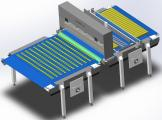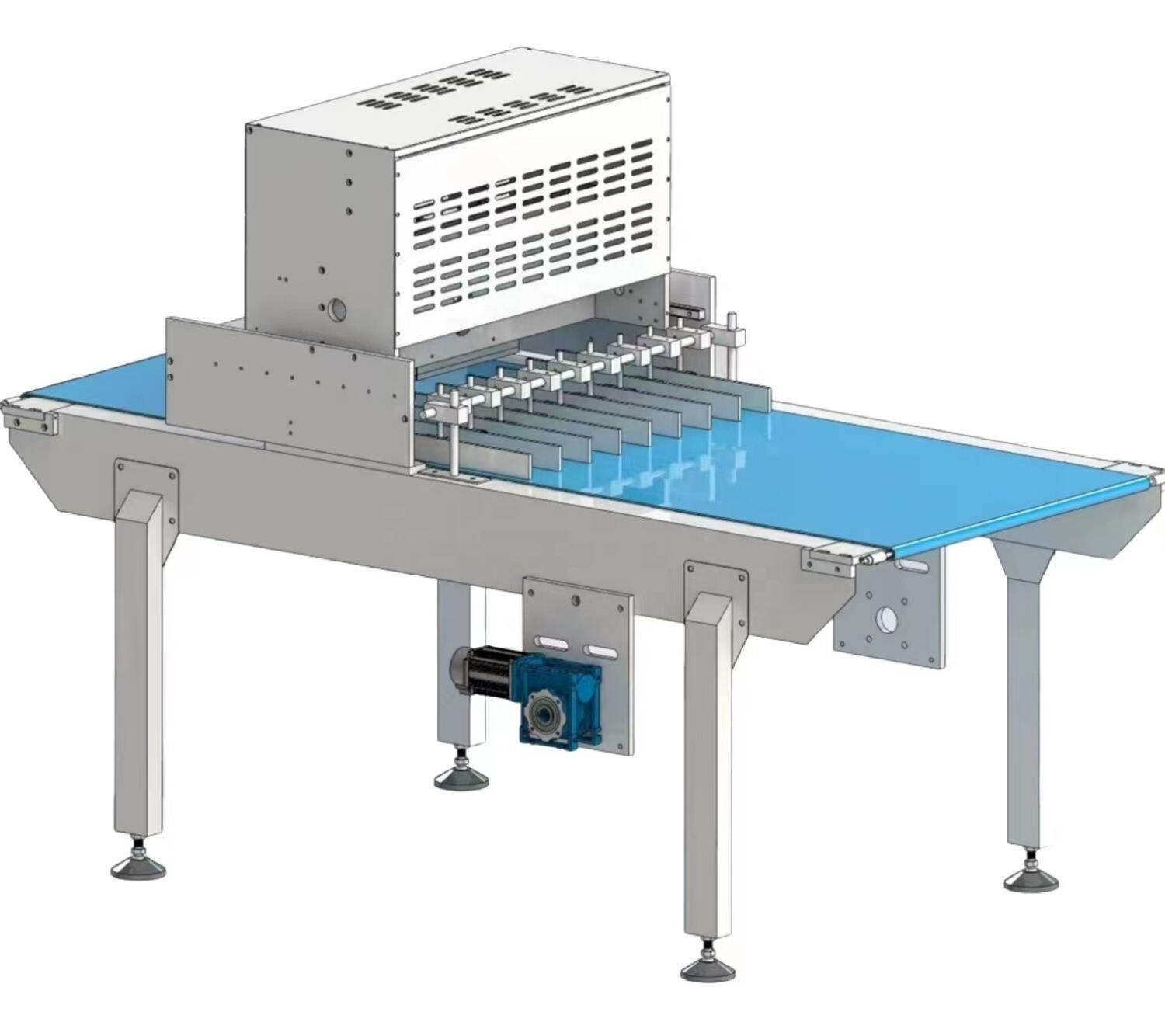Key Factors in Blade Selection for Ultrasonic Candy Cutting Machines
Impact of Candy Hardness on Blade Performance
Hardness, being the key factor in choosing a blade to be used with an ultrasonic caramels cutting machine. The hardness of different kinds of candy varies, so the type of blade used also varies. For example, hard confectionery may need blades that are hard hitting to produce an effective cutting action. A study has shown that using standard blades haven’t shown any damage due to breaking of harder candies. So for that, It's better to go with a harder material made blade to keep its lifeline longer and cutting precision. This manner helps the blade to be durable against many cuts without wearing a lot. Candy hardness is traditionally measured on the Shore hardness scale and needs to be matched with blade materials and designs to optimize performance.
Blade Teeth Patterns: Serrated vs. Smooth Edge Applications
Choosing between serrated and fine-edged knives plays an important role to achieve cutting success when ultrasonic cutting is applied in cutting of candy machines. A serrated knife will grip the candy better and prevent it from slipping around while you cut. On the other hand, the soft candies need to be cut with a smooth-edged blade, where regularity and accuracy are more important. Expert advice suggests designing the blade to meet the unique textures of the candy. This also reduces the risk of damage to the candy and enhances the appearance of the product. The optimal blade edge for different types of candy should consider a balance between operational efficiency and the cutting accuracy.
Importance of Blade Thickness and Cutting Surface Area
Both the thickness of the blades and their cutting surface area have a significant impact on performance and efficiency of ultrasonically driven candy cutting machines. In general, thicker blades are tougher and can cut through heavier material while holding their shape. A larger area of cut surface may allow higher rates of production, especially with batches of candy products. It is common industry practice to experiment with different thicknesses to determine an optimal balance of performance, longevity and material savings. With the appropriate selection of blade thickness, manufacturers can improve production efficiency and achieve precise cutting results with quality cut candy.
Understanding Ultrasonic Blade Types for Confectionery Cutting
High-Frequency Vibration Mechanism in Ultrasonic Blades
Ultrasonic blades When you want to cut a sweet treat, use of high frequency vibrations does a better job. These vibrations are anti-friction and anti-overheating and they minimize phenomenon that the cutting gets dirty and the delicate sweets are deformed or melt. Working at the ideal frequency between 20 kHz and 40 kHz, ultrasonic blades are able to assure precision cut and maintain integrity of the product with different types of candy. This application for candy cutting is always being recommended to manufacturers, as it brings some advantages for good quality and stable product.
Interchangeable Blade Systems for Multi-Product Operations
The potential of modular blade system is considerable for sugar confectionery producers. These plant designs are designed to cope with a wide variety of production requirements, for companies to easily move from one type of confectionery product to another, without the need for complex changes in equipment. Featuring quick-change blade holders, such systems provide operators with greater flexibility and can bring productivity gains. The data also demonstrates that interchangeable makes for increased efficiency across different product lines, which is also ideal for multi-product operations in the confectionery industry.
Blade Selection Based on Candy Hardness and Texture
Hard/Brittle Candies: Diamond-Coated Blade Solutions
Diamond-coated blades are ideal when working with hard or brittle candies (peppermint, nougat, etc.). These knives have great sharpness and durability and will cut through the candy without distorting its shape. Diamond coatings are initially expensive, but they last a very long time and don't require the regular replacement of other coatings. One example is a study case of confectioners using diamond-coated blades that led to a notable downtime savings on account of blade performance loss, the result of a higher resilience and productivity.
Handling Sticky Candies: Anti-Adhesion Serrated Blades
Challenging sticky candies (hello, marshmallow, caramel) become less of a sticky situation when cut with serrated blades that resist sticking. These scrapers are constructed to prevent build-up, allowing the equipment to run more effectively. And, through coatings or a serrated option, they also promote product release, key to not only cleanliness, but also scrap. The blades help manufacturers easily manage sticky products for improved production runs and longer time between cleanings.
Soft and Delicate Confections: Precision Thin Blades
For delicate, soft applications such as fondant or cream-based products, delicate thin blades guarantee less destruction, and a proper slice. These blades are manufactured to tight tolerances for high performance, ensuring the quality of products. One-piece thin blades offer significant advances in product surface-smoothness, and according to a survey of confectioners, the surface smoothness of confectionery products made with precision one-piece thin blades has also been significantly improved, showing the significance of the selection of the blade for such meeting-consumer-expectation surfaces.
By understanding candy-specific needs and selecting the appropriate blade, confectionery producers can optimize their operations, improve efficiency, and achieve consistent product quality.
Optimizing Blade Materials for Durability and Efficiency
Hardened Steel vs. Titanium Alloys for Abrasive Candies
The correct choice of blade material is essential with abrasive candies. Tempered steel blades provide solid strength for cutting, but they might not be as strong as high-abrasion materials such as titanium alloys, which are not only lighter but also stronger. Studies suggest that there is a longer life when abrasive candies are utilized, which contributes to a lower downtime and blade replacement costs. This is an important decision as it influences cutting performance and maintenance intervals, thus maximizing long-term productivity.

Non-Stick Coatings for Sugar-Rich Formulations
In the world of confections, the use of a non-stick coating on the blades is necessary to provide for clean cuts that would not leave sugary residues to hamper the performance of the cutting blade. Tests have demonstrated that the blades treated with slippery surfaces result in a pronounced reduction of cleaning and maintenance requirements thereby improving the overall performance. Such coatings provide for increased throughput over time by minimizing down time for cleaning and the like, thereby enabling manufacturers to operate their production facilities at maximum levels.
Corrosion Resistance in High-Moisture Environments
The choice of corrosion-resistant materials is a must in humid conditions if blade life is to be extended. Use stainless steel and other specially coated options to avoid rusting and weathering problems. According to statistical studies corrosion resistant blades can save you a lot of money if you work in an environment prone to moisture. This option maintains the same cutting performance while improving durability and service life for better value.
Advanced Cutting Parameters Adjustment
Frequency Settings for Different Candy Densities
"Setting" Frequency according to candy's density can largely increase cutting yield, especially for Ultrasonic CANDY Cutting machines. Firmer candies may require faster rpm’s for them to work best and make an accurate cut. Industry experts suggest periodic calibrations on those machines to match their frequency setting with their current production needs. This preventive action guarantees quality candy every time we make it. Studies have shown that perfect frequency settings yield an excellent quality of production, i.e., quality of candy produced can be improved significantly by setting a proper frequency, also it is found that the frequency must be set differently, for candies of different densities processed.
Amplitude Control for Clean Edge Preservation
Amplitude regulation is important to maintain clean edged cuts, particularly with delicate candies, which are easily deformed. Correct amplitude settings ensure holding the edge and a nice tight clean edge to make the compatible, clean looking facemask. Not only does this accuracy add to the appealing look of the product, it helps to maintain customer satisfaction as consistently trimmed confectionery is in demand. Companies have found that better customer ratings are achieved using the optimized amplitude control, demonstrating an advantage of using the exact amplitude control in the cutting of the candy.
Speed Optimization for Production Throughput
Cutting speeds need to be maximized to avoid the reduction in production speed without sacrifice in quality. With instant adjustments according to production feedback, your imaging workflows remain efficient and you can strike a balance between speed and accuracy. Based on the operational data, operation at optimized speed can bring substantial production efficiency improvements. Through strategic control of cutting speed, manufacturers can run a clean operation that maximizes production and quality. Adopt these solutions and they will seamlessly incorporate speed optimization into candy cutting, improving system productivity.
FAQ
What factors should be considered when selecting a blade for ultrasonic candy cutting?
Consider the candy hardness, blade teeth patterns, blade thickness, and the specific type of candy being cut. Choosing the right material and design is crucial for efficiency and quality.
How do ultrasonic blades benefit candy cutting?
Ultrasonic blades use high-frequency vibrations to reduce friction and heat, ensuring clean cuts without damaging delicate candy structures, and maintaining product quality.
Why are interchangeable blade systems advantageous?
They offer flexibility in production, allowing manufacturers to switch between different confectionery products efficiently without extensive machine changes, improving productivity.
Which blade materials are best for hard or abrasive candies?
Diamond-coated blades and titanium alloys are preferred due to their sharpness, durability, and ability to withstand high-abrasion conditions, reducing wear and maintenance.
Why is blade corrosion resistance important in confectionery production?
Corrosion-resistant blades are essential in high-moisture environments to prevent degradation, maintaining cutting quality and enhancing the longevity and reliability of the blades.
Table of Contents
- Key Factors in Blade Selection for Ultrasonic Candy Cutting Machines
- Understanding Ultrasonic Blade Types for Confectionery Cutting
- Blade Selection Based on Candy Hardness and Texture
- Optimizing Blade Materials for Durability and Efficiency
- Advanced Cutting Parameters Adjustment
-
FAQ
- What factors should be considered when selecting a blade for ultrasonic candy cutting?
- How do ultrasonic blades benefit candy cutting?
- Why are interchangeable blade systems advantageous?
- Which blade materials are best for hard or abrasive candies?
- Why is blade corrosion resistance important in confectionery production?

